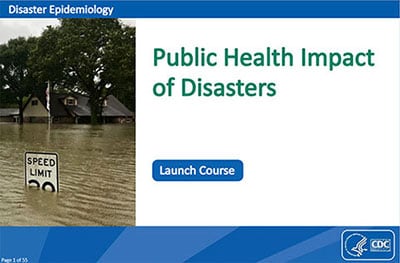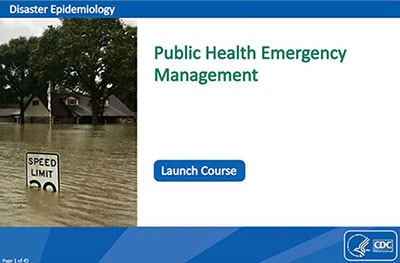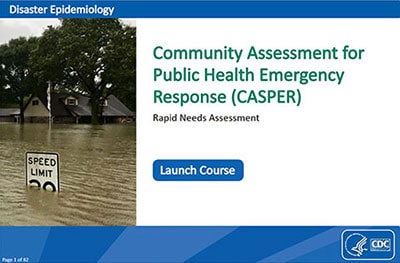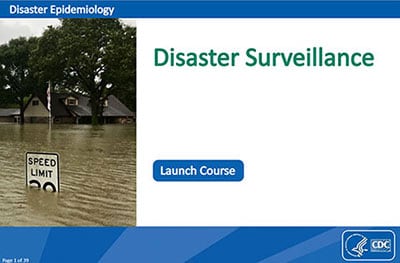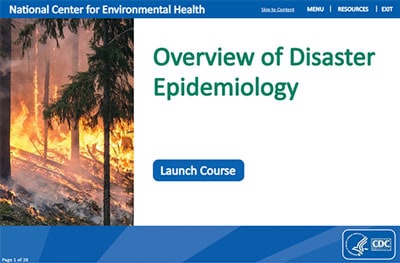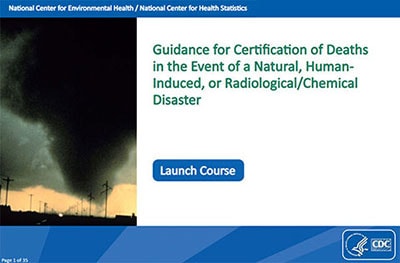Continuing Education Information
At the conclusion of the session, the participant will be able to:
- Define basic concepts such as emergency, disaster, catastrophe, hazard, risk, and vulnerability.
- Differentiate between physical occurrences and disasters.
- Explain how patterns of mortality, morbidity, and economic damage vary across different types of communities.
- Describe how disasters create health and public health impacts, both directly and indirectly.
- Discuss how and why different segments of the population are disproportionately vulnerable to the health and public health impacts of disasters.
- Define and assess the health status of individuals and populations, including determinants of health and illness, factors contributing to health promotion and disease prevention, factors influencing the use of health services, and epidemiology (e.g., incidence, prevalence) of diseases.
- Describe the importance of interprofessional collaboration in disaster epidemiology
FACULTY/ CREDENTIALS:
Amy Helene Schnall, MPH, Epidemiologist, Disaster Epidemiology & Response Team (DERT), National Center for Environmental Health (NCEH), Centers for Disease Control and Prevention (CDC)
ORIGINATION DATE: October 14, 2019
RENEWAL DATE: October 14, 2021
EXPIRATION DATE: October 14, 2023
URL: http://www.cdc.gov/nceh/hsb/disaster/training.htm
HARDWARE/SOFTWARE: Computer Hardware; Internet connection; Browser
MATERIALS: None
TARGET AUDIENCE: Physicians, Registered Nurses, Administrators, Advanced Practice Nurses, Medical Assistants, Certified Health Education Specialist, Public Health Emergency Preparedness (PHEP) coordinators, Emergency Responders, Emergency Manager, Pharmacist, Physician Assistants, Epidemiologists, Veterinarians, Program Managers.
PREREQUISITES: Recommended prerequisites include basic knowledge of public health emergency preparedness and response and epidemiological principles.
FORMAT: This is a web-based training course.
CONTACT INFORMATION: Amy Helene Schnall, (770) 488-3422
ACCREDITATION STATEMENTS:
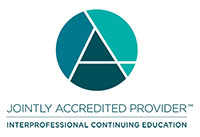
CME: The Centers for Disease Control and Prevention designates this enduring activity for a maximum of 1.0 AMA PRA Category 1 Credits™. Physicians should claim only the credit commensurate with the extent of their participation in the activity.
CNE: The Centers for Disease Control and Prevention designates this activity for 0.8 nursing contact hours.
CPE: The Centers for Disease Control and Prevention designated this Knowledge-based event for pharmacists to receive 0.075 CEUs in pharmacy education. The Universal Activity Number is JA4008229-0000-21-203-H05-P. Once credit is claimed, an unofficial statement of credit is immediately available on TCEOnline. Official credit will be uploaded within 60 days on the NABP/CPE Monitor.
CEU: The Centers for Disease Control and Prevention is authorized by IACET to offer 0.1 CEU’s for this program.
CECH: Sponsored by the Centers for Disease Control and Prevention, a designated provider of continuing education contact hours (CECH) in health education by the National Commission for Health Education Credentialing, Inc. This program is designated for Certified Health Education Specialists (CHES®) and/or Master Certified Health Education Specialists (MCHES®) to receive up to 1.0 total Category I continuing education contact hours. Maximum advanced level continuing education contact hours available are 0. Continuing Competency credits available are 1.0. CDC provider number 98614.
AAVSB/RACE: This program was reviewed and approved by AAVSB RACE program for 1.0 hours of continuing education. Participants should be aware that some boards have limitations on the number of hours accepted in certain categories and/or restrictions on certain methods of delivery of continuing education. Please contact the AAVSB RACE program if you have any comments/concerns regarding this program’s validity or relevancy to the veterinary profession.
DISCLOSURE: In compliance with continuing education requirements, all presenters must disclose any financial or other associations with the manufacturers of commercial products, suppliers of commercial services, or commercial supporters as well as any use of unlabeled product(s) or product(s) under investigational use.
CDC, our planners, content experts, and their spouses/partners wish to disclose they have no financial interests or other relationships with the manufacturers of commercial products, suppliers of commercial services, or commercial supporters. Planners have reviewed content to ensure there is no bias.
Content will not include any discussion of the unlabeled use of a product or a product under investigational use.
CDC did not accept commercial support for this continuing education activity.
Instructions for Obtaining Continuing Education (CE)
In order to receive continuing education (CE) for WB4273 Disaster Epidemiology: Public Health Impact of Disasters please visit TCEO and follow these 9 Simple Steps before 10/14/2023.
Complete the activity
Complete the Evaluation at www.cdc.gov/GetCE
Pass the posttest at __80___% at www.cdc.gov/GetCE
FEES: No fees are charged for CDC’s CE activities.
PROGRAM DESCRIPTION: The Disaster Epidemiology: Public Health Emergency Management course provides an overview of public health emergency management and planning for a disaster response and recovery. This course covers: the fundamental obligations and major functions of public health agencies; agencies involved in disaster management; relevant federal laws, statutes, and authorities; the National Response Framework; the Incident Command System; and all-hazard plan writing.
At the conclusion of the session, the participant will be able to:
- Describe the role and function of public health agencies in a disaster.
- List the implications of the relevant federal laws, statutes, and authorities related to public health’s role in a disaster.
- Identify the major components of the National Incident Management System.
- Define various positions within an Incident Command System.
- List components of an emergency response plan for public health.
- Identify the roles pharmacists play in emergency preparedness (e.g., bioterrorism and chemical terrorism, natural disasters) and response (e.g., medication dispensing, information provision, vaccination response teams, medical reserve corps) on the local community and national levels. Provide care and evaluate outcomes.
- Describe the importance of interprofessional collaboration in emergency management.
FACULTY/CREDENTIALS:
Amy Helene Schnall, MPH, Epidemiologist, Disaster Epidemiology & Response Team (DERT), National Center for Environmental Health (NCEH), Centers for Disease Control and Prevention (CDC)
ORIGINATION DATE: October 14, 2019
RENEWAL DATE: October 14, 2021
EXPIRATION DATE: October 14, 2023
URL: http://www.cdc.gov/nceh/hsb/disaster/training.htm
HARDWARE/SOFTWARE: Computer Hardware; Internet connection; Browser
MATERIALS: None
TARGET AUDIENCE: Physicians, Registered Nurses, Administrators, Advanced Practice Nurses, Medical Assistants, Certified Health Education Specialist, Public Health Emergency Preparedness (PHEP) coordinators, Emergency Responders, Emergency Manager, Pharmacist, Physician Assistants, Epidemiologists, Veterinarians, Program Managers.
PREREQUISITES: Recommended prerequisites include basic knowledge of public health emergency preparedness and response and epidemiological principles.
FORMAT: This is a web-based training course.
CONTACT INFORMATION: Amy Helene Schnall, (770) 488-3422
ACCREDITATION STATEMENTS:

CME: The Centers for Disease Control and Prevention designates this enduring activity for a maximum of 1.0 AMA PRA Category 1 Credits™. Physicians should claim only the credit commensurate with the extent of their participation in the activity.
CNE: The Centers for Disease Control and Prevention designates this activity for 0.8 nursing contact hours.
CPE: The Centers for Disease Control and Prevention designated this Knowledge-based event for pharmacists to receive 0.075 CEUs in pharmacy education. The Universal Activity Number is JA4008229-0000-21-202-H05-P. Once credit is claimed, an unofficial statement of credit is immediately available on TCEOnline. Official credit will be uploaded within 60 days on the NABP/CPE Monitor.
CEU: The Centers for Disease Control and Prevention is authorized by IACET to offer 0.1 CEU’s for this program.
CECH: Sponsored by the Centers for Disease Control and Prevention, a designated provider of continuing education contact hours (CECH) in health education by the National Commission for Health Education Credentialing, Inc. This program is designated for Certified Health Education Specialists (CHES®) and/or Master Certified Health Education Specialists (MCHES®) to receive up to 1.0 total Category I continuing education contact hours. Maximum advanced level continuing education contact hours available are 0. Continuing Competency credits available are 1.0. CDC provider number 98614.
AAVSB/RACE: This program was reviewed and approved by AAVSB RACE program for 1.0 hours of continuing education. Participants should be aware that some boards have limitations on the number of hours accepted in certain categories and/or restrictions on certain methods of delivery of continuing education. Please contact the AAVSB RACE program if you have any comments/concerns regarding this program’s validity or relevancy to the veterinary profession.
DISCLOSURE: In compliance with continuing education requirements, all presenters must disclose any financial or other associations with the manufacturers of commercial products, suppliers of commercial services, or commercial supporters as well as any use of unlabeled product(s) or product(s) under investigational use.
CDC, our planners, content experts, and their spouses/partners wish to disclose they have no financial interests or other relationships with the manufacturers of commercial products, suppliers of commercial services, or commercial supporters. Planners have reviewed content to ensure there is no bias.
Content will not include any discussion of the unlabeled use of a product or a product under investigational use.
CDC did not accept commercial support for this continuing education activity.
Instructions for Obtaining Continuing Education (CE)
In order to receive continuing education (CE) for WB4274 Disaster Epidemiology: Public Health Emergency Management please visit TCEO and follow these 9 Simple Steps before 10/14/2023.
Complete the activity
Complete the Evaluation at www.cdc.gov/GetCE
Pass the posttest at 80% at www.cdc.gov/GetCE
FEES: No fees are charged for CDC’s CE activities.
At the conclusion of the session, the participant will be able to:
- Define Rapid Needs Assessment (RNA).
- Demonstrate a basic understanding of different types of RNAs in emergency response.
- Describe Community Assessment for Public Health Emergency Response (CASPER) methodology and when to conduct a CASPER.
- Explain how to prepare for a CASPER.
- Identify steps for conducting a CASPER in the field.
- Understand how to analyze and interpret results of a CASPER.
- Conduct a continuing assessment of community health assets and needs.
- Describe the importance of interprofessional collaboration in conducting a RNA.
FACULTY/ CREDENTIALS: Amy Helene Schnall, MPH, Epidemiologist, Disaster Epidemiology & Response Team (DERT), National Center for Environmental Health (NCEH), Centers for Disease Control and Prevention (CDC)
ORIGINATION DATE: October 14, 2019
RENEWAL DATE: October 14, 2021
EXPIRATION DATE: October 14, 2023
URL: http://www.cdc.gov/nceh/hsb/disaster/training.htm
HARDWARE/SOFTWARE: Computer Hardware; Internet connection; Browser
MATERIALS: None
TARGET AUDIENCE: Physicians, Registered Nurses, Administrators, Advanced Practice Nurses, Medical Assistants, Certified Health Education Specialist, Public Health Emergency Preparedness (PHEP) coordinators, Emergency Responders, Emergency Manager, Pharmacist, Physician Assistants, Epidemiologists, Veterinarians, Program Managers.
PREREQUISITES: Recommended prerequisites include basic knowledge of public health emergency preparedness and response and epidemiological principles.
FORMAT: This is a web-based training course.
CONTACT INFORMATION: Amy Helene Schnall, (770) 488-3422
ACCREDITATION STATEMENTS:

CME: The Centers for Disease Control and Prevention designates this enduring activity for a maximum of 1.25 AMA PRA Category 1 Credits™. Physicians should claim only the credit commensurate with the extent of their participation in the activity.
CNE: The Centers for Disease Control and Prevention designates this activity for 1.1 nursing contact hours.
CPE: The Centers for Disease Control and Prevention designated this Knowledge-based event for pharmacists to receive 0.125 CEUs in pharmacy education. The Universal Activity Number is JA4008229-0000-21-204-H05-P. Once credit is claimed, an unofficial statement of credit is immediately available on TCEOnline. Official credit will be uploaded within 60 days on the NABP/CPE Monitor.
CEU: The Centers for Disease Control and Prevention is authorized by IACET to offer 0.1 CEU’s for this program.
CECH: Sponsored by the Centers for Disease Control and Prevention, a designated provider of continuing education contact hours (CECH) in health education by the National Commission for Health Education Credentialing, Inc. This program is designated for Certified Health Education Specialists (CHES®) and/or Master Certified Health Education Specialists (MCHES®) to receive up to 1.0 total Category I continuing education contact hours. Maximum advanced level continuing education contact hours available are 0. Continuing Competency credits available are 1.0. CDC provider number 98614.
AAVSB/RACE: This program was reviewed and approved by AAVSB RACE program for 1.4 hours of continuing education. Participants should be aware that some boards have limitations on the number of hours accepted in certain categories and/or restrictions on certain methods of delivery of continuing education. Please contact the AAVSB RACE program if you have any comments/concerns regarding this program’s validity or relevancy to the veterinary profession.
DISCLOSURE: In compliance with continuing education requirements, all presenters must disclose any financial or other associations with the manufacturers of commercial products, suppliers of commercial services, or commercial supporters as well as any use of unlabeled product(s) or product(s) under investigational use.
CDC, our planners, content experts, and their spouses/partners wish to disclose they have no financial interests or other relationships with the manufacturers of commercial products, suppliers of commercial services, or commercial supporters. Planners have reviewed content to ensure there is no bias.
Content will not include any discussion of the unlabeled use of a product or a product under investigational use.
CDC did not accept commercial support for this continuing education activity.
Instructions for Obtaining Continuing Education (CE)
In order to receive continuing education (CE) for WB4275 Disaster Epidemiology: Community Assessment for Public Health Emergency Response (CASPER) please visit TCEO and follow these 9 Simple Steps before 10/14/2023.
Complete the activity
Complete the Evaluation at www.cdc.gov/GetCE
Pass the posttest at __80___% at www.cdc.gov/GetCE
FEES: No fees are charged for CDC’s CE activities.
At the conclusion of the session, the participant will be able to:
- Identify reasons why disaster surveillance is important.
- Explain the purpose of morbidity surveillance.
- Explain the purpose of mortality surveillance.
- Describe tools to assist in conducting mortality surveillance.
- Define and assess the health status of individuals and populations, including determinants of health and illness, factors contributing to health promotion and disease prevention, factors influencing the use of health services, and epidemiology (e.g., incidence, prevalence) of diseases.
- Describe the importance of interprofessional collaboration in disaster surveillance.
FACULTY/ CREDENTIALS: Amy Schnall, MPH, Epidemiologist, Centers for Disease Control and Prevention (CDC), National Center for Environmental Health (NCEH), Disaster Epidemiology & Response Team (DERT)
ORIGINATION DATE: October 16, 2019
RENEWAL DATE: October 16, 2021
EXPIRATION DATE: October 16, 2023
URL: http://www.cdc.gov/nceh/hsb/disaster/training.htm
HARDWARE/SOFTWARE: Computer Hardware; Internet connection; Browser
MATERIALS: None
TARGET AUDIENCE: Physicians, Registered Nurses, Administrators, Advanced Practice Nurses, Medical Assistants, Certified Health Education Specialist, Public Health Emergency Preparedness (PHEP) coordinators, Emergency Responders, Emergency Manager, Pharmacist, Physician Assistants, Epidemiologists, Veterinarians, Program Managers.
PREREQUISITES: Recommended prerequisites include basic knowledge of public health emergency preparedness and response and epidemiological principles.
FORMAT: This is a web-based training course.
CONTACT INFORMATION: Amy Helene Schnall, (770) 488-3422
ACCREDITATION STATEMENTS:

CME: The Centers for Disease Control and Prevention designates this enduring activity for a maximum of 1.0 AMA PRA Category 1 Credits™. Physicians should claim only the credit commensurate with the extent of their participation in the activity.
CNE: The Centers for Disease Control and Prevention designates this activity for 0.8 nursing contact hours.
CPE: The Centers for Disease Control and Prevention designated this Knowledge-based event for pharmacists to receive 0.1 CEUs in pharmacy education. The Universal Activity Number is JA4008229-0000-21-205-H05-P. Once credit is claimed, an unofficial statement of credit is immediately available on TCEOnline. Official credit will be uploaded within 60 days on the NABP/CPE Monitor.
CEU: The Centers for Disease Control and Prevention is authorized by IACET to offer 0.1 CEU’s for this program.
CECH: Sponsored by the Centers for Disease Control and Prevention, a designated provider of continuing education contact hours (CECH) in health education by the National Commission for Health Education Credentialing, Inc. This program is designated for Certified Health Education Specialists (CHES®) and/or Master Certified Health Education Specialists (MCHES®) to receive up to 1.0 total Category I continuing education contact hours. Maximum advanced level continuing education contact hours available are 0. Continuing Competency credits available are 1.0. CDC provider number 98614.
AAVSB/RACE: This program was reviewed and approved by AAVSB RACE program for 1.0 hours of continuing education. Participants should be aware that some boards have limitations on the number of hours accepted in certain categories and/or restrictions on certain methods of delivery of continuing education. Please contact the AAVSB RACE program if you have any comments/concerns regarding this program’s validity or relevancy to the veterinary profession.
DISCLOSURE: In compliance with continuing education requirements, all presenters must disclose any financial or other associations with the manufacturers of commercial products, suppliers of commercial services, or commercial supporters as well as any use of unlabeled product(s) or product(s) under investigational use.
CDC, our planners, content experts, and their spouses/partners wish to disclose they have no financial interests or other relationships with the manufacturers of commercial products, suppliers of commercial services, or commercial supporters. Planners have reviewed content to ensure there is no bias.
Content will not include any discussion of the unlabeled use of a product or a product under investigational use.
CDC did not accept commercial support for this continuing education activity.
Instructions for Obtaining Continuing Education (CE)
In order to receive continuing education (CE) for WB4277 Disaster Epidemiology: Disaster Surveillance please visit TCEO and follow these 9 Simple Steps before 10/16/2023.
Complete the activity
Complete the Evaluation at www.cdc.gov/GetCE
Pass the posttest at 83% at www.cdc.gov/GetCE
FEES: No fees are charged for CDC’s CE activities.
At the conclusion of the session, the participant will be able to:
- Define what is meant by a ‘disaster’.
- Differentiate between direct and indirect effects of a disaster.
- Identify potential effects of a disaster.
- Describe the role of a disaster epidemiologist.
- Provide public health related educational material or services tailored to the needs and background of a given audience.
- Describe the importance of interprofessional collaboration in disaster epidemiology.
FACULTY/CREDENTIALS: Amy Schnall, MPH, Epidemiologist, Centers for Disease Control and Prevention (CDC), National Center for Environmental Health (NCEH), Disaster Epidemiology & Response Team (DERT)
ORIGINATION DATE: October 15, 2019
RENEWAL DATE: October 15, 2021
EXPIRATION DATE: October 15, 2023
URL: http://www.cdc.gov/nceh/hsb/disaster/training.htm
HARDWARE/SOFTWARE: Computer Hardware; Internet connection; Browser
MATERIALS: None
TARGET AUDIENCE: Physicians, Registered Nurses, Administrators, Advanced Practice Nurses, Medical Assistants, Certified Health Education Specialist, Public Health Emergency Preparedness (PHEP) coordinators, Emergency Responders, Emergency Manager, Pharmacist, Physician Assistants, Epidemiologists, Veterinarians, Program Managers.
PREREQUISITES: Recommended prerequisites include basic knowledge of public health emergency preparedness and response and epidemiological principles.
FORMAT: This is a web-based training course.
CONTACT INFORMATION: Amy Helene Schnall, (770) 488-3422
ACCREDITATION STATEMENTS:

CME: The Centers for Disease Control and Prevention designates this enduring activity for a maximum of 1.0 AMA PRA Category 1 Credits™. Physicians should claim only the credit commensurate with the extent of their participation in the activity.
CNE: The Centers for Disease Control and Prevention designates this activity for 0.8 nursing contact hours.
CPE: The Centers for Disease Control and Prevention designated this Knowledge-based event for pharmacists to receive 0.075 CEUs in pharmacy education. The Universal Activity Number is JA4008229-0000-21-206-H05-P. Once credit is claimed, an unofficial statement of credit is immediately available on TCEOnline. Official credit will be uploaded within 60 days on the NABP/CPE Monitor.
CEU: The Centers for Disease Control and Prevention is authorized by IACET to offer 0.1 CEU’s for this program.
CECH: Sponsored by the Centers for Disease Control and Prevention, a designated provider of continuing education contact hours (CECH) in health education by the National Commission for Health Education Credentialing, Inc. This program is designated for Certified Health Education Specialists (CHES®) and/or Master Certified Health Education Specialists (MCHES®) to receive up to 1.0 total Category I continuing education contact hours. Maximum advanced level continuing education contact hours available are 0. Continuing Competency credits available are 1.0. CDC provider number 98614.
AAVSB/RACE: This program was reviewed and approved by AAVSB RACE program for 1.0 hours of continuing education. Participants should be aware that some boards have limitations on the number of hours accepted in certain categories and/or restrictions on certain methods of delivery of continuing education. Please contact the AAVSB RACE program if you have any comments/concerns regarding this program’s validity or relevancy to the veterinary profession.
DISCLOSURE: In compliance with continuing education requirements, all presenters must disclose any financial or other associations with the manufacturers of commercial products, suppliers of commercial services, or commercial supporters as well as any use of unlabeled product(s) or product(s) under investigational use.
CDC, our planners, content experts, and their spouses/partners wish to disclose they have no financial interests or other relationships with the manufacturers of commercial products, suppliers of commercial services, or commercial supporters. Planners have reviewed content to ensure there is no bias.
Content will not include any discussion of the unlabeled use of a product or a product under investigational use.
CDC did not accept commercial support for this continuing education activity.
Instructions for Obtaining Continuing Education (CE)
In order to receive continuing education (CE) for WB4276 Disaster Epidemiology: Overview of Disaster Epidemiology please visit TCEO and follow these 9 Simple Steps before 10/15/2023.
Complete the activity
Complete the Evaluation at www.cdc.gov/GetCE
Pass the posttest at 80% at www.cdc.gov/GetCE
FEES: No fees are charged for CDC’s CE activities.
PROGRAM DESCRIPTION: The Disaster Epidemiology: Guidance for Certification of Deaths in the Event of a Natural, Human-Induced, or Radiological/Chemical Disaster course is based on the Centers for Disease Control and Prevention’s National Center for Health Statistics’ reference guide for disaster-related death certification, published in 2017, that aims to improve the accuracy of disaster-related mortality reporting by alleviating some of the inconsistencies in determining disaster-related deaths. This course is geared towards death certifiers such as medical examiners, coroners, physicians, and justices of the peace, and will cover: the importance of including disaster-related data on the death certificate; the two types of disaster-related deaths, direct and indirect; how to determine if a death is disaster-related; and how to complete the death certificate for disaster-related death.
OBJECTIVES:
At the conclusion of the session, the participant will be able to:
- Describe the importance of accurate death certification for disaster-related mortality surveillance.
- Identify a disaster-related death.
- Explain how to complete the death certificate for a disaster-related death.
- Describe the importance of interprofessional collaboration in disaster-related mortality surveillance.
- Provide public health related educational material or services tailored to the needs and background of a given audience.
FACULTY/CREDENTIALS: Amy Helene Schnall, MPH, Epidemiologist, Disaster Epidemiology & Response Team (DERT), National Center for Environmental Health (NCEH), Centers for Disease Control and Prevention (CDC)
ORIGINATION DATE: October 16, 2019
RENEWAL DATE: October 16, 2021
EXPIRATION DATE: October 16, 2023
URL: http://www.cdc.gov/nceh/hsb/disaster/training.htm
HARDWARE/SOFTWARE: Computer Hardware; Internet connection; Browser
MATERIALS: None
TARGET AUDIENCE: Physicians, Registered Nurses, Administrators, Advanced Practice Nurses, Medical Assistants, Certified Health Education Specialist, Public Health Emergency Preparedness (PHEP) coordinators, Emergency Responders, Emergency Manager, Pharmacist, Physician Assistants, Epidemiologists, Veterinarians, Program Managers.
PREREQUISITES: Recommended prerequisites include basic knowledge of public health emergency preparedness and response and epidemiological principles.
FORMAT: This is a web-based training course.
CONTACT INFORMATION: Amy Helene Schnall, (770) 488-3422
ACCREDITATION STATEMENTS:

CME: The Centers for Disease Control and Prevention designates this enduring activity for a maximum of 1.0 AMA PRA Category 1 Credits™. Physicians should claim only the credit commensurate with the extent of their participation in the activity.
CNE: The Centers for Disease Control and Prevention designates this activity for 0.8 nursing contact hours.
CPE: The Centers for Disease Control and Prevention designated this Knowledge-based event for pharmacists to receive 0.1 CEUs in pharmacy education. The Universal Activity Number is JA4008229-0000-21-210-H05-P.
Once credit is claimed, an unofficial statement of credit is immediately available on TCEOnline. Official credit will be uploaded within 60 days on the NABP/CPE Monitor.
CEU: The Centers for Disease Control and Prevention is authorized by IACET to offer 0.1 CEU’s for this program.
CECH: Sponsored by the Centers for Disease Control and Prevention, a designated provider of continuing education contact hours (CECH) in health education by the National Commission for Health Education Credentialing, Inc. This program is designated for Certified Health Education Specialists (CHES®) and/or Master Certified Health Education Specialists (MCHES®) to receive up to 1.0 total Category I continuing education contact hours. Maximum advanced level continuing education contact hours available are 0. Continuing Competency credits available are 1.0. CDC provider number 98614.
AAVSB/RACE: This program was reviewed and approved by AAVSB RACE program for 1.0 hours of continuing education. Participants should be aware that some boards have limitations on the number of hours accepted in certain categories and/or restrictions on certain methods of delivery of continuing education. Please contact the AAVSB RACE program if you have any comments/concerns regarding this program’s validity or relevancy to the veterinary profession.
DISCLOSURE: In compliance with continuing education requirements, all presenters must disclose any financial or other associations with the manufacturers of commercial products, suppliers of commercial services, or commercial supporters as well as any use of unlabeled product(s) or product(s) under investigational use.
CDC, our planners, content experts, and their spouses/partners wish to disclose they have no financial interests or other relationships with the manufacturers of commercial products, suppliers of commercial services, or commercial supporters. Planners have reviewed content to ensure there is no bias.
Content will not include any discussion of the unlabeled use of a product or a product under investigational use.
CDC did not accept commercial support for this continuing education activity.
Instructions for Obtaining Continuing Education (CE)
In order to receive continuing education (CE) for WB4278 Disaster Epidemiology: Guidance for Certification of Deaths in the Event of a Natural, Human-Induced, or Radiological/Chemical Disaster please visit TCEO and follow these 9 Simple Steps before 10/16/2023.
Complete the activity
Complete the Evaluation at www.cdc.gov/GetCE
Pass the posttest at __83___% at www.cdc.gov/GetCE
FEES: No fees are charged for CDC’s CE activities.
- Community Assessment for Public Health Emergency Response (CASPER)
- CDC Emergency Preparedness and Response
- CDC Natural Disaster and Extreme Weather Events
- Radiation Emergencies
- Disaster Epidemiology: FAQs
- Public Health Assessment and Surveillance after a Disaster
- CSTE Disaster Epidemiology Subcommitteeexternal icon
- NIH Disaster Research Response (DR2)external icon
- Recent Publications in Disaster Epidemiology
